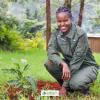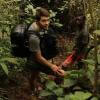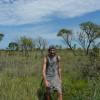Seeking Knowledge/Resources about Soil Monitoring
10 April 2024 9:53pm
14 April 2024 12:21am
Hi! If you wouldn't mind, would we be able to exchange emails and connect? I'd love to have a short discussion and get some feedback regarding my senior project
14 April 2024 1:50pm
Sounds good. Just sent you a private message.
Wildlabs PPWC course
14 April 2024 11:12am
non-invasive technique to apply GPS collars without catching?
14 June 2021 12:01pm
2 April 2024 7:18pm
Not sure what happened to the excerpt I wanted to post. Apperently the Alaska study authors had some scepticism themselves.
I would be extremely worried about catching wrong species in many cases - with potentially detrimental effects.
12 April 2024 2:17pm
My study in particular is only looking at species that go under fence holes in Southern Africa. The hole determines species size and juveniles for these species are so small the collar would just fall off. I think a proper study could really determine these collars could be useful if the right study species and setting location was determined.
13 April 2024 11:48am
Might very well be so! I highly encourage you to take up the challenge!
Modelling functional connectivity?
11 April 2024 11:55am
Research Assistant, Lion Landscapes in Nanyuki
11 April 2024 9:49am
Join the Seeed Vision Challenge and Explore Conservation Tech!
10 April 2024 9:15am
Applied hierarchical modelling (AHM) for species distribution and abundance
9 April 2024 7:22pm
Comparing local ecological knowledge with camera trap data to study mammal occurrence in anthropogenic landscapes of the Garden Route Biosphere Reserve
9 April 2024 7:09pm
Combining camera traps and online surveys provided a more comprehensive understanding of mammal communities in anthropogenic landscapes, increasing both spatial coverage and the number of species sightings.
Post Doctoral Research Assistant at ZSL
9 April 2024 7:03pm
Celebrating #IWD2024 in Collaboration with SHE Changes Climate, Shortlist Futures & Women in Renewable Energy
 Esther Githinji
Esther Githinji
9 April 2024 6:32pm
Conservation Science Intern - Space for Giants, Nanyuki
9 April 2024 8:55am
The IUCN-SSC Crocodile Specialist Group (CSG) Conference
9 April 2024 8:21am
Wildlife Drones will be at the 21st Australasian Bat Society Conference
9 April 2024 6:03am
WILDLABS AWARDS 2024 - FinDrop: Accessible Acoustic Monitoring for Mesophotic Marine Environments
5 April 2024 10:22pm
7 April 2024 6:07pm
Congrats @MattyD797 and team!!! We do a lot of work in the underwater bioacoustic realm and your tool certainly seems like it would be a great instrumental addition to the community. Look forward to learning more about your project!
Liz
WILDLABS AWARDS 2024 - Enhancing Pollinator Conservation through Deep NeuralNetwork Development
7 April 2024 5:55pm
Underwater advertisement call of the threatened Telmatobius rubigo (Anura: Telmatobiidae
6 April 2024 9:56pm
Online training workshop: camera trap distance sampling, 27-31 May 2024.
6 April 2024 4:00am
Job Opportunity - Wildlife Protection Solutions
5 April 2024 9:22pm
Bioacoustic device security in urban parks
8 March 2024 2:49pm
24 March 2024 4:53am
Yes, I agree with Panji......make sure you have notes of where you put them and remember that photos of trees without leaves look completely different 6 months later......not that I would ever make that mistake.........well not again......especially after spending 2 days trying to find 3 ARU's.
24 March 2024 9:38pm
We suggest and use Python Locks for urban areas here in Australia. Can also screw the Mini 2 to a tree or phone post with the python lock.
5 April 2024 12:55pm
We've deployed passive acoustic monitors in various urban environments without any issues of theft, even in locations where camera traps and other technology has been historically taken or vandalised. I think acoustic sensors generally look less valuable than other technology, and I would recommend removing or covering any stickers or labels on devices that would otherwise make them more appealing! Placing them in hedgerows or on trees with some (but not too much!) foliage will help keep them well hidden too.
Ethics in conservation
15 March 2024 8:53am
3 April 2024 4:38pm
Hi Sherril,
I can't believe this was posted almost a month ago. And more surprising that there are no comments about it yet.
That experience you had is one of the kind, because most people in conservation don't get to deal with ethics and moral issues in the front line that often. It's just because most people do desk work. Including managing directors of projects deployed in remote places. I can relate your experience to any field, I would say it's almost a human behavior classics. I understand it can be frustrating and also a lonely journey. Myself I had experience a lot of that in the last years. To a point that I was almost quitting doing my best for conservation, I was burnt out for seeing that the reality was a very different picture from the marketing about it. But I feel fortunate that I have been observing these realities in the sector first-hand for long time now. And because I did it all independently and self funded I can speak my mind about it. Which there are not many people with that freedom I found out.
You talk about illegal practices, in countries where corruption seems more "brutal", for governments and organizations the fact that something is illegal can be pretty relative concept. And methods follow short when that is the case. Many times I observed apparent combat of poaching activities, but after years of observation and doing my own research it was clear that the local governments were pretty aware of illegal activities and just not being honest enough to address them. Mainly because the donors are far away, way removed from the realities in the front line, so the remoteness of some places allows for a very flexible understanding of ethics in some cases.
Your experience is very valuable, I'm glad to hear that you got the permits at the end. And good luck with your research, remember to write, record and share your experiences. There is a lot of people in the same situation. Stay independent, stay free, share your knowledge.
Best, Luciano
nowforwildlife.org
5 April 2024 8:19am
Hi Luciano,
Thank you for joining in in the discussion!
I really love your perspectives on this. It is exciting to learn that I am not all alone in this. You know, at one point you think that some of these things are because you are not effectively doing your work, but then it is just how the system works. I am glad I figured it out. My main concern was how do I really get my data, remain safe from what seems to be an intricate, closely guarded practice and also protect my study participants and their communities from unintentional exposure to the securities. Through the process, I have gained lots of experience in navigating ethics in conservation, especially when the topic in question is illegal.
DIY VHF receivers?
12 March 2024 2:51pm
29 March 2024 4:32pm
Hi Brandon,
I agree and think VHF will always have better range than UHF. Given how commonly it's used in wildlife tracking, it also makes perfect sense to use it if possible. The trade-off for us was to go for lower cost and higher availability parts. This is particularly a problem for VHF receivers, as you mentioned in your original message. But, SDR is good option potentially for VHF (and UHF), especially given the success of MOTUS.
Range of our 433MHz UHF tags was usually around 250m (up to 500m) LOS, using an external antenna and a high transmission power. We also used high gain, omnidriectional antennas on the receiver end. Tags were triggered by an accelerometer threshold so that they'd save a bit of power whilst animals were resting.
More than happy to discuss further and help if I can.
Cheers,
Rob
3 April 2024 5:04am
Hi Brandon,
This is hard for me to write, because I don't have good news for you. You can find many receivers and transmitters for 433MHz that are used for remote control, such as wireless doorbells, garage door openers, lost model locators, etc. These are extremely cheap, a couple of dollars literally. While this tech can be modified to operate with wildlife tags (around 150MHz), we are talking about hacking RF, not to be approached lightly.
If you really need to DIY, I see 2 options: migrate to 433MHz and build/rebuild all your kit (tags, collars, receivers, locators). Commercial solutions are cheap and available, the work remaining is not much above handyman level. But it is work, and not just work but also testing.
The other option is to remain with 150MHz (although you can make your own tags) and modify an aviation receiver (it lets you listen in to aircraft talking to each other or to the airport). These receivers operate at 130MHz, which puts it in spitting range of 150MHz wildlife tags (this matters). This is the option I'd go for, just because I know it can be done, and I have less sense than curiosity.
4 April 2024 9:05pm
You mention you're working with an engineer, here are a couple of pointers:
- with an SDR (the "digital USB receivers" you mention) you can scan some bandwidth to detect radio pulses. I'm only familiar with the Lotek coded VHF transmitters but they can be received as in the Motus Sensorgnomes. I can point you at the code used there, it does involve a good amount of digital signal filtering/analysis code. One issue with the SDRs is that they're pretty power hungry so you need to plan on more solar panel and battery than you may like, e.g. even rPi Zero + SDR is probably >300mA. Another issue can be interference in that SDRs have a very wideband front-end and so TV, radio, and other stuff can desensitize the front-end.
- there are integrated receivers (ICs) that can be tuned to 150Mhz and can detect VHF transmissions, it's easy for non-coded ones, a bit more involved for coded ones. Specifically, the Semtech sx1231 or sx1276 series are widely available (often called Hope RF69 or RF96, which are modules with those chips). You need someone comfortable writing a customized driver that uses OOK mode or RSSI detection. The other issue is that while there are many suitable boards available for 433/868/915Mhz (e.g. Adafruit, Sparkfun, LilyGo, and many others) you most likely won't find one for 150Mhz. However, for RX-only the matching isn't so super important if you have a good antenna and the signal isn't crazy weak. From a power point of view these can sip power so you can run one on an 18650 for days and a small 1W-5W solar panel is most likely all you need.
Hope this helps...
Completely irrational animals...
3 April 2024 7:13pm
3 April 2024 9:09pm
3 April 2024 9:20pm
4 April 2024 5:05am
Mammal responses to global changes in human activity vary by trophic group and landscape
3 April 2024 4:52pm
These researchers used camera trapping as a lens to view mammal responses to changes in human activity during the COVID-19 pandemic.
Not so silent spectators: How spectator vessels at international sailing regattas alter marine soundscapes
3 April 2024 4:50pm
Check out how water-based sporting events are impacting underwater noise pollution for marine life.
Fonseca Leadership Program
3 April 2024 4:46pm
Rescuers hope AI will help reunite orphaned whale with its family in B.C.
3 April 2024 4:43pm
Finwave, while currently in beta-testing, is being used to help reunite an orphaned whale with its family.
Seventh International Conference on the Effects of Noise on Aquatic Life
3 April 2024 4:34pm
EuropaBON'sFinal Stakeholder Conference
3 April 2024 4:29pm
EcoAssist - Free AI models for camera traps photos identification
3 April 2024 7:16am


























12 April 2024 2:32pm
Hi Frida.
We are currently doing soil monitoring for ecological restoration in Australia with an organization called Bush Heritage Australia. It's been ongoing for about four years and it's in collaboration with BHA and also Monash University's soil science department. There's more info about the project here: